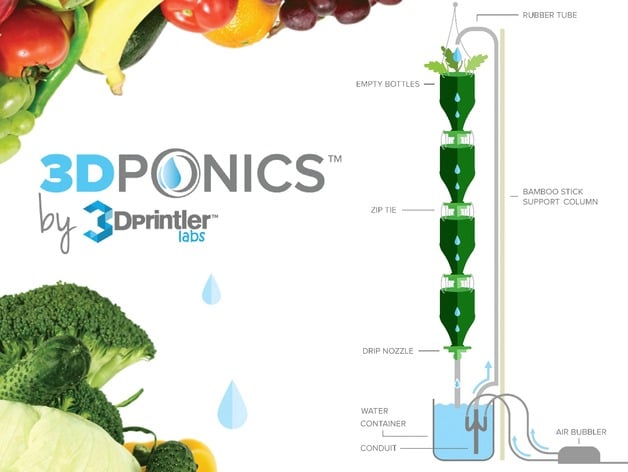
3Dponics - Open-Source Collaboration - Building the Ultimate Space Farm
thingiverse
3D-Printing + Hydroponics = 3Dponics Download the FREE 3Dponics digital files, modify them, engage online and help us create the first 3D-printed garden for use in space! Join our open-source collaboration project and help develop one of the greenest technologies of the future: http://goo.gl/kb28Ht INNOVATION THROUGH COLLABORATION. How to get started: Step 1: Download 3Dponics parts. Step 2: Join the 3Dponics Google+ community. Step 3: Share your ideas and engage with other members. Step 4: Innovate. Instructions HOW TO BUILD A BASIC FOUR-BOTTLE 3DPONICS SYSTEM Materials 3D-printed parts: -One conduit - http://www.thingiverse.com/thing:379184 (print using raft setting) -Four drip nozzles - http://www.thingiverse.com/thing:379061 and http://www.thingiverse.com/thing:379041 (prints well without supports or raft) -One silencer - http://www.thingiverse.com/thing:379225 (prints well without supports or raft) Other materials: -Four empty plastic bottles (2L recommended) -Four plants (tomatoes, cucumbers, green peppers, herbs, etc.) -Hydroponics growth media (growstones or equivalent), pre-soaked -Aeration kit for aquariums -Vertical support column for tubing -Air pump -Rubber tubing for an aquarium air pump or similar -Zip ties -Support structure (coat rack or a ceiling hook recommended) -Scissors -Water jug (4 L, 8 L or 9 L recommended) -Hole puncher -Utility knife INSTRUCTIONS: STEP 1: Download and print the 3D-printed parts. Recommended settings (using Makerbot): Medium quality; 0.2 mm; 10% fill; 2 shells STEP 2: Build the support column: (a) Take several bamboo sticks and fasten them together using zip ties to create about a 6-foot pole. (b) Secure the conduit to the bottom of the bamboo pole using zip ties, making sure that the end of the conduit sticks out a little bit from the end of the bamboo stick. This ensures better suction. Cut off the excess plastic from the zip ties. STEP 3: Prepare the plastic bottles. (a) Cut off the bottoms of the plastic bottles with a sharp knife. Discard the bottoms. (b) Using a hole punch, make four holes along the edge of each bottle (the holes should be placed evenly around the bottle, one across from the other) STEP 4: Attach the rubber tubing (a) Measure how much tubing you’ll need to cover the entire length of the column. Ensure you have a little bit extra at the top of the column (this will be needed for attaching the silencer). (b) Attach the tube to the bamboo pole using zip ties. Cut off the excess plastic from the zip ties when you’re done. (c) At the bottom of the bamboo pole, cut the tubing in the spot where it connects with the conduit, and attach the two parts together, making sure to push the conduit into the tubing as far as it will go. STEP 5: Connect the tubing to the air pump. STEP 6: Set up the vertical bottle system: (a) Take the 3D-printed drip nozzles and screw them onto the plastic bottles. (b) Turn the bottles upside-down so that the nozzles are pointing downward. Working with one bottle at a time, fill each bottle halfway with the pre-soaked growstones, add the plant (removing as much soil from the roots as possible) and then add some more growstones until the plant can stand up securely on its own without falling over. (c) Using zip ties, attach the first bottle to the hook at the top of the support column (this is why using a coat hanger is the best option—it has a built-in hook). As you finish each bottle, secure it to the support column. Tested on MakerBot, Ultimaker and Formlabs printers That's it! You're now ready to grow your own fresh produce! Please join our online community and share your experiences: http://goo.gl/kb28Ht
With this file you will be able to print 3Dponics - Open-Source Collaboration - Building the Ultimate Space Farm with your 3D printer. Click on the button and save the file on your computer to work, edit or customize your design. You can also find more 3D designs for printers on 3Dponics - Open-Source Collaboration - Building the Ultimate Space Farm.
